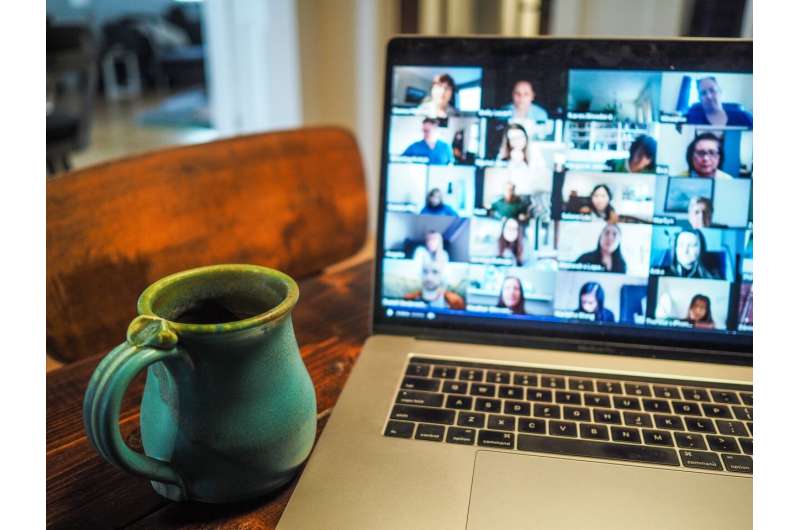Science and Nature news 
Credit: Unsplash/CC0 Public Domain
Part of many people’s pandemic experience included working from home. Even after lockdowns, videoconferencing remains a big part of life as people continue to work remotely, connect with families and friends online, and attend virtual events hosted on videoconferencing platforms.
Spending hours on video calls, however, can be exhausting and manifest as physical, emotional, or cognitive tiredness—a phenomenon known as videoconferencing fatigue (VF). Now, researchers in Singapore have asked if a relationship between virtual backgrounds and VF exists and what the underlying mechanisms are.
“We show that the use of different types and contents of virtual backgrounds can contribute to VF,” said Heng Zhang, co-author of the study published in Frontiers in Psychology and a researcher at the Nanyang Technological University Wee Kim Wee School of Communication and Information.
“Users who utilize video virtual backgrounds experience higher levels of VF compared to those who use image or blurred virtual backgrounds.”
Tiring backgrounds
The researchers carried out a survey with more than 600 participants in which they asked people whether they use virtual backgrounds, and what type of background (static image, blurred image, video, or no virtual background) they choose.
The researchers also measured VF using a five-point scale that indicated levels of general, visual, social, motivational, and emotional fatigue. Participants were aged between 22 and 76 years and worked from home around three days a week.
The results showed that participants who use video backgrounds experienced the highest levels of VF. Users who use blurred backgrounds also experienced higher VF than those who use static images.
“Our brains automatically react to new information in the environment. This consumes cognitive resources, which then increases cognitive load and consequently leads to VF,” Zhang explained.
The key, the researchers said, is how much new information is contained in the background.
“Image backgrounds initially present new information, but users might gradually shift their attention elsewhere. Blurred backgrounds don’t introduce new information, but occasionally users may catch glimpses of the real environment, which presents new information. Video backgrounds, however, continuously introduce new information, constantly interrupting users’ attention and putting a demand on cognitive resources.”
Virtual nature
In addition to the type of background, the environment that is depicted in the background can also influence VF.
“Users who use nature-themed backgrounds report lower levels of VF compared to others,” Zhang said. Other backgrounds, such as office settings or public spaces can increase users’ pressure to self-present as if they actually were in one of those settings, leading to increased fatigue.
“In a work setting, a nature-themed image background might be the ideal choice,” Zhang pointed out.
When being on calls in relaxed settings, participants who used lighthearted and funny backgrounds reported the lowest VF levels. It is important that users choose backgrounds appropriately, as different contexts call for different types of backgrounds, the authors said.
Making thoughtful choices could not only enhance meeting effectiveness, but also improve the users’ psychological experience, reducing the fatigue associated with videoconferencing.
Optimizing video calls
Their study provides a scientific foundation for further optimizing the videoconferencing experience and helping users make more informed choices, the researchers said. These insights may be especially valuable to users who use video calls in their work and could help them maintain well-being while maximizing the benefits of this way of working.
Nevertheless, the authors said that further study is needed to focus on how different age groups and video call purposes influence the relationship between virtual backgrounds and VF. In addition—and despite the fact that many people spend significant amounts of time watching themselves when on a video call—the role of other users’ backgrounds on VF needs to be investigated.
“A more comprehensive understanding of the role of virtual backgrounds in videoconferencing could provide more targeted recommendations for future research and practice,” concluded Zhang.
More information:
Exploring the links between type and content of virtual background use during videoconferencing and videoconference fatigue, Frontiers in Psychology (2024). DOI: 10.3389/fpsyg.2024.1408481
Citation:
How your Zoom background could influence how tired you feel after a video call (2024, September 19)
retrieved 19 September 2024
from https://phys.org/news/2024-09-background-video.html
This document is subject to copyright. Apart from any fair dealing for the purpose of private study or research, no
part may be reproduced without the written permission. The content is provided for information purposes only.


